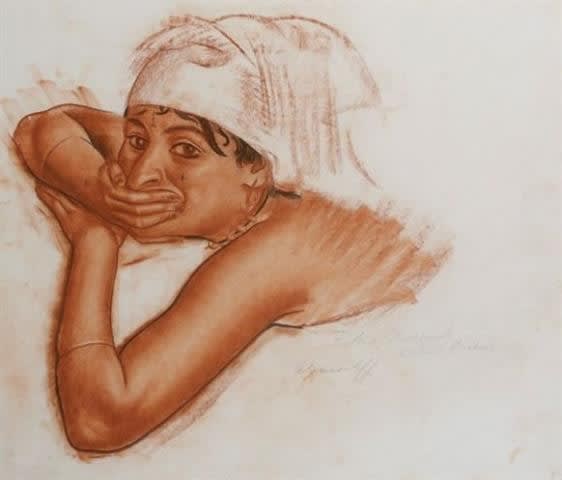Between 1914 and 1915, Iacovleff travelled throughout Italy. From 1909 to 1918 Iacovleff worked at the Satirikon and Novy Satirikon magazines and in 1912 he became a member of the Mir Isskusstva (World of Art) Association of Artists.
In the second half of the first decade of the twentieth century Iacovleff busied himself with portrait painting and drawing, achieving a great deal of success in the technique of sanguine drawing.
Iacovleff also tried his hand at the monumental decorative arts. Some of his projects (a number of frescoes for the church of St. Nicholas of Myra in Bari and the Kazan Station in Moscow) remained unfinished. He painted the ceiling of the Firsanov family house in Moscow and in collaboration with D. Grigoriev and S. Sudeikin, he provided the decorations for the Comedian’s Bivouac vaudeville cabaret in Petrograd. He created the fresco for the dome of the Ida Rubinstein Opera, the hall of the Prince Yusupov Hotel in Paris (1934) and the Joy of Life panel for the central salon of the “Normandy” steam ship (1935).
While collecting ethnographic materials for the frescoes at the Kazan Station in Moscow, he visited the Middle East and then China, Mongolia and Japan in 1917, before moving to France in 1918. He lived in Paris and on the Island of Capri.
In 1924-1925 he took part in an expedition organised by "Citroen” through the Sahara and equatorial Africa completing a huge series of pictures and drawings in the process. These works are full of the most subtle observation while at the same time being a hymn to the neo-classical enjoyed great public acclaim and the artist was awarded the Order of the Legion d'Honneur (1926)
Iacovleff published several albums in French, most notably The Far East in the drawings and paintings of Alexander Iacovleff (1922), The Chinese Theatre in paintings, sanguine drawings and sketches by Alexander Iacovleff (1922) and A. Iacovleff : African drawings and paintings (1927).
In 1928, Iacovleff travelled around Ethiopia. A supporter of loyal relations with the Soviet government, he became one of the few émigré artists who was given the honour of exhibiting in their homeland during their lifetime (Leningrad, 1928). Between 1928 and 1930 he painted a cycle of mythological canvases in the spirit of the frescoes at Pompey. A new large series entitled A Cycle of Wanderings was created by Iacovleff as the result of an expedition to Asia, also organised by Citroen, which followed a route from Syria to Vietnam (1931-1932).
In 1934, Iacovleff was invited to the United States to head the department of painting at the school attached to the Museum of Decorative Arts in Boston. From 1934 to 1937, he travelled around America and Mexico marking his journey with a huge number of works.
Iacovleff died on the 12th of May 1938 in Paris at the age of fifty after an unsuccessful surgical operation.

